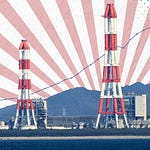
Hey Power Japan readers,
This is the second installment in a series of five posts about Japan’s energy strategy — the 7th Strategic Energy Plan (or the SEP) — that’s being revised as we speak. Part 1 covered the government’s high-level thinking and approach to energy policy.
This post focuses on how the strategy positions nuclear energy in the overall energy roadmap. Nuclear energy in Japan is an enormous topic that can fill several shelves in a library. My purpose here is to concisely organize what the 7th SEP says about the potential, opportunities, and barriers surrounding nuclear energy.
On a separate note, if you missed the survey for readers I recently sent out, please take a few minutes to answer the 7 questions here.
Thank you for reading!
Walter
Since Fukushima, nuclear energy has slowly and unsteadily clawed its way back into Japan’s energy system. The proposed draft of the 7th SEP officially marks this revival.
The last SEP, published in 2021, famously announced that Japan “aims to reduce its dependence on nuclear power as much as possible.” In stark contrast, the current SEP draft adopts as its mantra that “it is critically important to maximize the use of both renewable energy and nuclear power.”
In fact, considering that nuclear energy was essentially a third rail in the years after the 2011 Fukushima Daiichi accident, nuclear is the clear winner in the 2040 electricity mix outlined in the 7th SEP draft. From accounting for 8.5% of the total electricity generation capacity in 2023, METI policymakers want to push this percentage up to around 20% by 2040.

This shifting attitude toward nuclear among energy policymakers and politicians over the last several years isn’t a surprise for people paying close attention to the Green Transformation strategy formulated by the Kishida administration and the nuclear consensus during the LDP presidential race last summer.
Even then, it’s significant that the upcoming SEP spells out how the government and industry will approach each facet of nuclear energy because it elevates this growing support into a formal strategy.
Like I mentioned in my first post, there are already legitimate criticisms by climate and clean energy advocates (this one by Hirata Kimiko, for example) that the government is relying too heavily on nuclear (and fossil fuels) and under-weighing the role of renewables, especially given Japan’s enormous renewable energy potential. I think these arguments are persuasive, as I’ve written here and elsewhere.
But my self-defined purpose in these posts is an analytical summary of the 7th SEP for the sake of understanding how Japanese energy policymakers view each of the power generation technologies. I may write a post that synthesizes all of the criticisms, but not here.
Diving into the nuclear section of the SEP draft, I posed myself several guiding questions : What position does nuclear occupy in energy policymakers’ minds? How do policymakers intend to increase the share of nuclear energy by 2040? What barriers and risks lie ahead? How do policymakers plan to regain the trust in nuclear among the Japanese public? And what’s the Japanese nuclear industry’s international position?
This post is organized along these questions. Here are the big takeaways.
Nuclear’s position: In sharp contrast to the 6th SEP in 2021, nuclear energy is held in high esteem now because of the same contextual reasons why Japanese energy discourse has shifted. But even before these shifts, Japan has historically valued nuclear energy for its extraordinary energy density, quasi-domestic supply chain, and for the stable, carbon-free, and relatively cost-competitive electricity (if we ignore capital expenditures, compensation for the damages from the Fukushima accident, and other enormous costs, that is) it generates. But this comes with a caveat of safety, safety, and more safety.
Growth plan: The government intends to increase nuclear by making maximum use of existing nuclear reactors. The first way of doing this is to restart as many of the 54 nuclear reactors as possible while adhering to the stringent regulations. The second way is to allow some reactors to operate longer than 60 years. And beyond this, the government wants to continue developing and deploying advanced reactors.
Listen to this episode with a 7-day free trial
Subscribe to Power Japan to listen to this post and get 7 days of free access to the full post archives.






